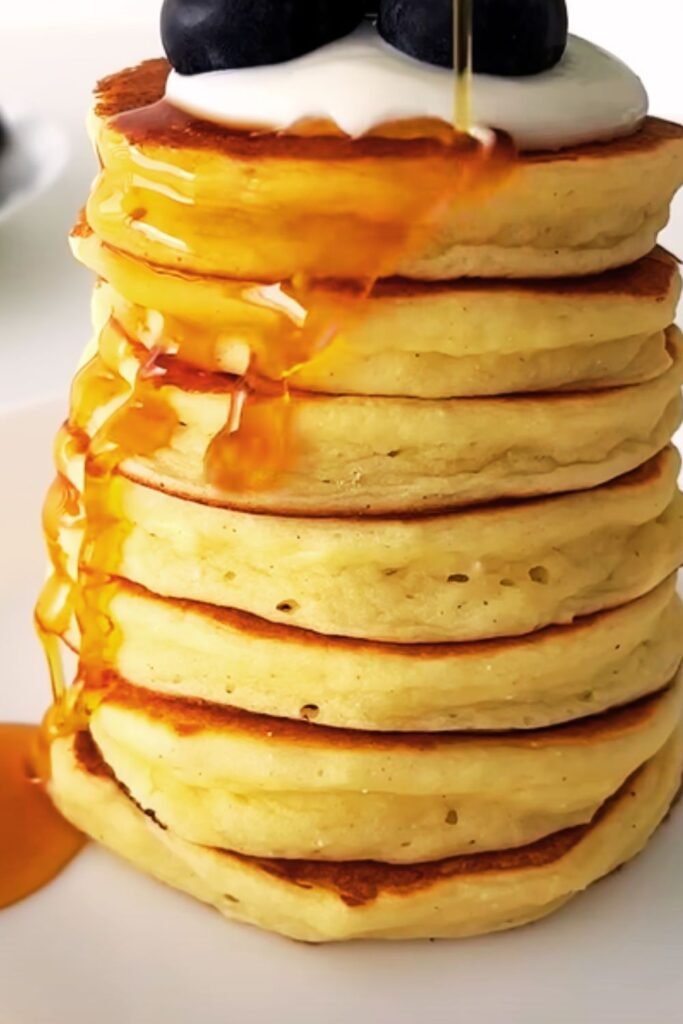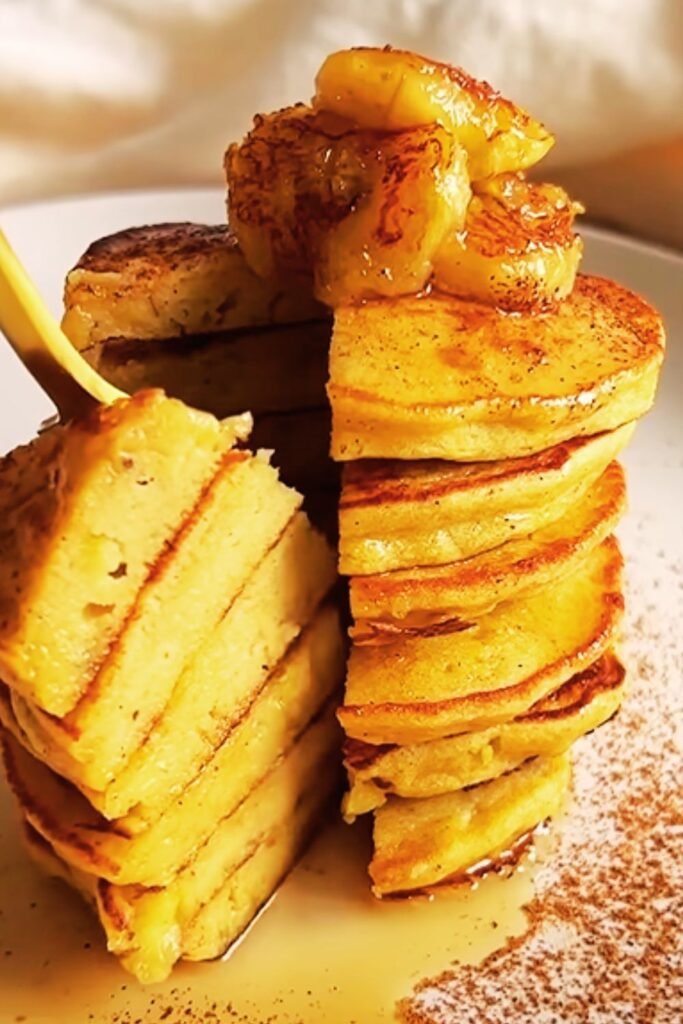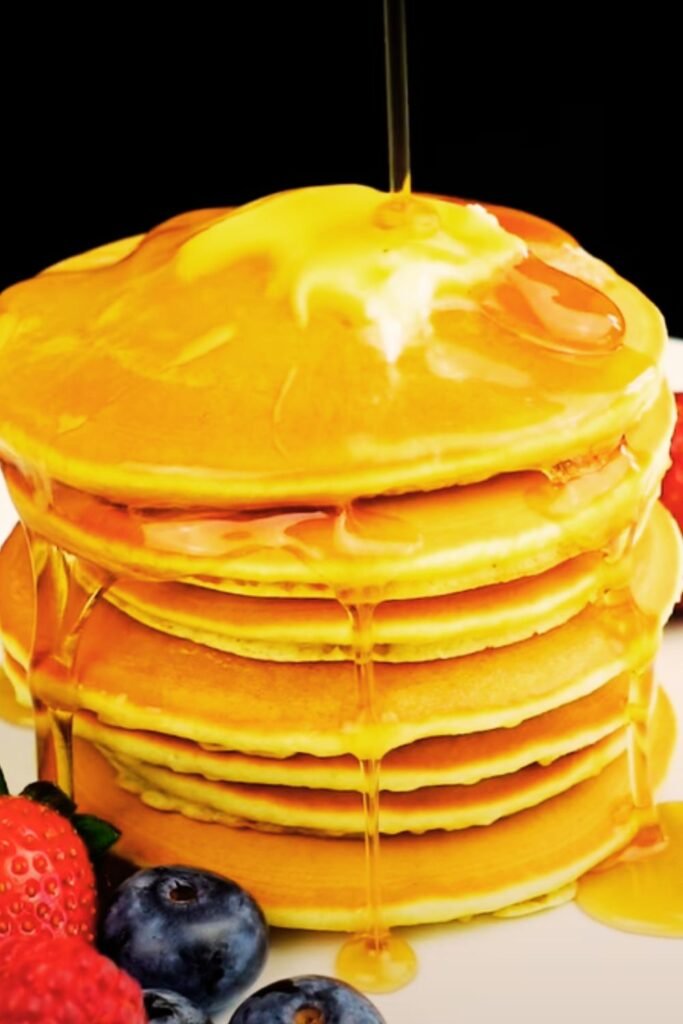Have you ever craved pancakes only to discover you’re out of eggs? Or perhaps you’re accommodating dietary restrictions that make traditional recipes off-limits? Well, I’ve got wonderful news for you! After countless kitchen experiments and many Sunday mornings of testing, I’ve perfected an eggless pancake recipe that rivals any traditional version.
These pancakes are impossibly fluffy, golden-brown on the outside, and tender on the inside—everything you want in a perfect pancake. Best of all, this recipe doesn’t require any fancy egg replacers or hard-to-find ingredients. Everything you need is probably sitting in your pantry right now!
Why Make Eggless Pancakes?
I started developing this recipe years ago when my niece, who has an egg allergy, came to visit. I wanted to create a special breakfast that everyone could enjoy without anyone feeling like they were missing out. Since then, I’ve continued to refine this recipe for several good reasons:
- Allergy-friendly: Perfect for those with egg allergies or sensitivities
- Vegan adaptable: Can easily be made fully plant-based with non-dairy milk
- Pantry-friendly: No last-minute store runs when you discover an empty egg carton
- Budget-conscious: Eggs can be expensive, especially during shortages
- Surprisingly delicious: Even egg lovers won’t miss the eggs!
The Science Behind Eggless Pancakes
Before diving into the recipe, let’s explore why eggs are traditionally used in pancakes and how we can achieve the same results without them.
In conventional pancake recipes, eggs serve multiple purposes:
| Egg Function | Eggless Alternative | How It Works |
|---|---|---|
| Binding | Mashed banana or applesauce | Natural sugars and pectins create structure |
| Leavening | Baking powder + vinegar | Creates bubbles through acid-base reaction |
| Moisture | Extra milk or yogurt | Adds needed liquid without thinning the batter |
| Richness | Oil or melted butter | Provides fat content for tender texture |
| Structure | Proper flour ratio | Gluten development provides necessary structure |
The key to successful eggless pancakes is understanding these functions and finding the right balance of substitutes. After many test batches (and some memorable failures!), I discovered that combining just the right amount of baking powder with a touch of acid creates the perfect reaction for fluffy pancakes without eggs.
Essential Ingredients

What makes this recipe special is its simplicity. You’ll need:
- All-purpose flour: The foundation of our pancakes, providing structure through gluten
- Baking powder: Our primary leavening agent that creates those essential bubbles
- Sugar: Just a touch for sweetness and helps with browning
- Salt: Enhances all the flavors and balances sweetness
- Milk: Provides moisture and helps create a pourable batter (use any plant milk for vegan version)
- Vinegar or lemon juice: Reacts with baking powder for extra lift and tenderness
- Vanilla extract: Adds warmth and depth of flavor
- Oil or melted butter: Provides necessary fat for tender pancakes and prevents sticking
- Optional mix-ins: Blueberries, chocolate chips, banana slices, or cinnamon
Perfect Eggless Pancake Recipe
Ingredients:
- 2 cups (240g) all-purpose flour
- 2½ teaspoons baking powder
- ½ teaspoon baking soda
- ¼ teaspoon salt
- 3 tablespoons granulated sugar
- 1¾ cups milk (dairy or plant-based)
- 1 tablespoon white vinegar or lemon juice
- 1 teaspoon vanilla extract
- 3 tablespoons vegetable oil or melted butter (plus more for cooking)
Instructions:
- Mix dry ingredients: In a large bowl, whisk together the flour, baking powder, baking soda, salt, and sugar until well combined.
- Prepare wet ingredients: In a separate bowl or measuring jug, combine the milk, vinegar (or lemon juice), vanilla extract, and oil. Let this mixture sit for 5 minutes—you’ll notice it may slightly curdle, which is exactly what we want! This creates a buttermilk-like effect.
- Combine wet and dry: Pour the wet ingredients into the dry ingredients and stir just until combined. It’s crucial not to overmix; some small lumps are perfectly fine. Overmixing develops gluten, which leads to tough pancakes.
- Rest the batter: Allow the batter to rest for 5-10 minutes. This gives the leavening agents time to start working and lets the flour hydrate properly.
- Heat the pan: Place a non-stick pan or griddle over medium heat. When a few drops of water sprinkled on the surface sizzle and evaporate quickly, you’re ready to cook.
- Cook the pancakes: Lightly brush the pan with oil or butter. Pour about ¼ cup of batter for each pancake. Cook until bubbles form on the surface and the edges look set (about 2-3 minutes).
- Flip with confidence: Carefully flip the pancakes and cook for another 1-2 minutes until golden brown and cooked through.
- Keep warm: Transfer cooked pancakes to a plate in a warm oven (around 200°F/95°C) while you cook the remaining batter.
Troubleshooting Tips
Even with a foolproof recipe, pancake-making can sometimes present challenges. Here’s how to address common issues:
| Problem | Cause | Solution |
|---|---|---|
| Pancakes too dense | Overmixed batter | Mix just until ingredients are combined; lumps are okay |
| Not rising properly | Old baking powder or baking soda | Test freshness by putting some in water—it should bubble vigorously |
| Burning too quickly | Heat too high | Lower temperature; pancakes need moderate heat to cook through |
| Pale and undercooked | Heat too low | Increase temperature slightly; ensure pan is fully preheated |
| Batter too thick | Too much flour | Add milk, 1 tablespoon at a time |
| Batter too thin | Too much liquid | Add flour, 1 tablespoon at a time |
Flavor Variations
One of the joys of this basic eggless pancake recipe is how easily it can be customized. Here are some of my favorite variations:
Blueberry Pancakes
Gently fold 1 cup of fresh or frozen blueberries into the batter just before cooking. If using frozen berries, don’t thaw them first, as this prevents color bleeding.
Banana Pancakes
Mash one ripe banana and add it to the wet ingredients. This not only adds flavor but also helps with binding and moisture. Reduce milk by 2 tablespoons to compensate.
Chocolate Chip Pancakes
Add ½ cup of chocolate chips to the batter. For an extra special touch, use mini chocolate chips for more even distribution.
Cinnamon Apple Pancakes
Add 1 teaspoon of ground cinnamon to the dry ingredients and fold in ½ cup of finely diced, peeled apples to the final batter.
Pumpkin Spice Pancakes
Add ⅓ cup of pumpkin puree to the wet ingredients along with 1 teaspoon of pumpkin pie spice. Reduce milk by 3 tablespoons.
Making Ahead and Storage

Make-Ahead Options
Dry Mix: Combine all dry ingredients and store in an airtight container for up to 3 months. When ready to use, just add the wet ingredients.
Batter: While pancakes are best made fresh, you can prepare the batter the night before and refrigerate it in a covered container. The pancakes may be slightly thicker the next day, so you might need to add a splash of milk before cooking.
Cooked Pancakes: Fully cooked pancakes can be refrigerated for up to 3 days or frozen for up to 3 months.
Storage Tips
Refrigerator Method:
- Allow pancakes to cool completely
- Place in an airtight container with parchment paper between layers
- Refrigerate for up to 3 days
- Reheat in a toaster, microwave, or warm oven
Freezer Method:
- Lay cooled pancakes in a single layer on a baking sheet
- Freeze until solid (about 1-2 hours)
- Transfer to freezer bags or containers, placing parchment paper between layers
- Freeze for up to 3 months
- Reheat directly from frozen in a toaster or microwave
Nutritional Information
For those who are watching their intake, here’s the approximate nutritional information per serving (2 medium pancakes, without toppings):
| Nutrient | Amount | % Daily Value* |
|---|---|---|
| Calories | 220 | – |
| Total Fat | 7g | 9% |
| Saturated Fat | 1g | 5% |
| Cholesterol | 0mg | 0% |
| Sodium | 330mg | 14% |
| Total Carbohydrates | 35g | 13% |
| Dietary Fiber | 1g | 4% |
| Sugars | 7g | – |
| Protein | 5g | 10% |
*Based on a 2,000 calorie diet
Serving Suggestions

A stack of perfect pancakes deserves perfect toppings! Here are some delicious serving ideas:
Sweet Options:
- Pure maple syrup (the real stuff makes a difference!)
- Fresh berries or sliced fruits
- Whipped cream or coconut whipped cream
- Nut butters (almond, peanut, or cashew)
- Chocolate or caramel sauce
- Fruit compotes or preserves
- Yogurt and granola
- Honey or agave nectar
- Powdered sugar dusting
Savory Options:
- Avocado slices with a sprinkle of everything bagel seasoning
- Sautéed mushrooms and herbs
- Cream cheese and chives
- Hummus and roasted vegetables
- Plant-based bacon bits and maple syrup (sweet-savory combination)
Complete Breakfast Ideas:
- Fresh fruit salad and yogurt parfait
- Smoothie on the side
- Hashbrowns or breakfast potatoes
- Fresh-squeezed orange juice or a fruit-infused water
- Hot chocolate for the kids (or adults—I won’t judge!)
Kid-Friendly Fun
One of the joys of making pancakes with children is turning breakfast into a creative activity. Here are some fun ideas that kids love:
- Pancake art: Use squeeze bottles to create shapes and designs
- Colorful pancakes: Add a few drops of food coloring to portions of batter
- Mini pancakes: Make silver dollar-sized pancakes for little hands
- Pancake bar: Set up a toppings station and let kids customize their own
- Funny faces: Use fruit slices, chocolate chips, and whipped cream to create faces on pancakes
Special Dietary Adaptations
This recipe is naturally egg-free, but can easily be modified for other dietary needs:
Gluten-Free Version
Replace all-purpose flour with a 1:1 gluten-free flour blend that contains xanthan gum. Add an extra ½ teaspoon of baking powder to help with rise.
Dairy-Free/Vegan Version
Use plant-based milk (oat milk works particularly well) and vegetable oil instead of butter. Ensure your sugar is vegan if making fully vegan pancakes.
Lower-Sugar Option
Reduce sugar to 1 tablespoon or replace with a natural sweetener like mashed banana or applesauce.
Whole Grain Version
Replace half the all-purpose flour with whole wheat flour. You may need to add an extra tablespoon or two of milk as whole wheat flour absorbs more liquid.
Common Questions About Eggless Pancakes
Q: Why did my pancakes turn out flat? A: The most common cause is old or expired leavening agents. Test your baking powder by putting a teaspoon in hot water—it should bubble vigorously. Another possible cause is overmixing the batter, which deflates the air bubbles necessary for rise.
Q: Can I make this batter ahead of time? A: Yes, but the leavening action will diminish over time. If making ahead, store in the refrigerator for no more than 12 hours and expect slightly less rise. You may need to add a splash of milk before cooking as the batter will thicken in the refrigerator.
Q: My pancakes are cooking unevenly. What’s wrong? A: This usually indicates hot spots in your pan. Try using a heavy-bottomed skillet or griddle that distributes heat more evenly. Also, make sure you’re preheating the pan adequately before adding batter.
Q: Can I double or halve this recipe? A: Absolutely! This recipe doubles or halves beautifully with no adjustments needed other than precise measurements.
Q: What’s the best milk substitute for dairy-free pancakes? A: Oat milk produces the most similar results to dairy milk, but almond, soy, and coconut milk all work well. Just note that coconut milk will add a slight coconut flavor.
Q: My pancakes are sticking to the pan. Help! A: Make sure your pan is properly preheated before adding batter, and don’t skimp on the oil or butter for cooking. A well-seasoned cast iron skillet or quality non-stick pan makes a big difference.
Q: Can I use oil instead of melted butter in the batter? A: Yes! Neutral oils like vegetable, canola, or sunflower oil work perfectly. You can even use melted coconut oil for a subtle coconut flavor.
Why These Pancakes Will Become Your Go-To
After years of making pancakes both with and without eggs, I’ve come to prefer this eggless version for several reasons:
- Consistency: They deliver reliable results every time
- Convenience: No worrying about having eggs on hand
- Versatility: The basic recipe adapts easily to countless variations
- Texture: Remarkably light and fluffy, never dense or rubbery
- Universal appeal: Everyone can enjoy them regardless of dietary restrictions
I’ve served these pancakes to countless friends and family members without mentioning they’re eggless, and no one has ever noticed the difference. In fact, I often receive compliments on how light and fluffy they are compared to traditional recipes!
Final Tips for Pancake Perfection
After making this recipe hundreds of times, I’ve gathered some final wisdom to share:
- A few lumps in the batter are good—resist the urge to mix until smooth
- Let the batter rest for at least 5 minutes before cooking
- Watch for bubbles on the surface to know when to flip
- The first pancake is often a “test pancake” that helps you calibrate temperature
- Keep cooked pancakes warm in a 200°F oven while you finish the batch
- For extra-fluffy pancakes, substitute ¼ cup of the milk with plain yogurt
- Fresh baking powder makes all the difference—replace yours every 6-12 months
Whether you’re making these pancakes because of dietary restrictions or simply because you’re out of eggs, I’m confident they’ll become a new favorite in your breakfast rotation. The simplicity, reliability, and delicious results make this recipe a true kitchen staple.
Happy cooking!